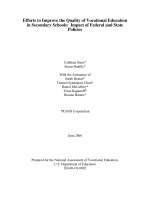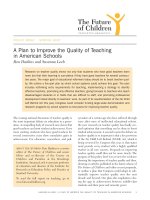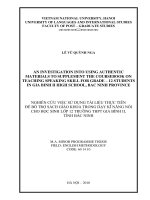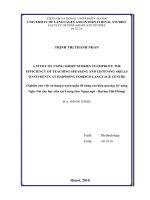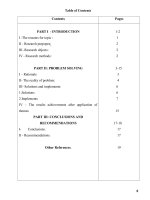Improve the quality of teaching reading english for grade 5 students
Bạn đang xem bản rút gọn của tài liệu. Xem và tải ngay bản đầy đủ của tài liệu tại đây (739.93 KB, 15 trang )
INDEX
Page
I. INTRODUCTION…………......………………………………….…...
1. REASON FOR CHOOSING THE TOPIC……………..………..........
2. PURPOSE OF THE RESEARCH…………………………....….........
3. RESEARCH OBJECT………………………………………..…...…
4. RESEARCH METHOD.......................………………………..…..…
II. CONTENT……………………………………………………..……...
1. RATIONALE……………………………………………..…..….……
2. THE PRESENT SITUATION OF THE PROBLEM……………...….
3. THE SOLUTION………………………………………….……....…..
3.1. Making connections…………..……….………………………...
3.2. Predicting………………..……………………………………....
3.3. Questioning…………..………………………………………….
3.4. Monitoring…………..……………………………………….….
3.5. Visualizing………………..………………………………….….
3.6. Summarizing………..…………………………………………...
3.7. Instruction of comprehension strategies.......................................
3.8. Practical applications of reading strategies...................................
4. THE EFFICIENCY OF THE RESEARCH……........................……...
III. CONCLUSION AND RECOMMENDATIONS…..……………....
1. CONCLUSION……………….....…………………………………….
2. RECOMMENDATIONS…………………..………………………….
2.1. To the leaders…………………...……………………………….
2.2. Acknowledgements……...………………………………………
REFERENCES…………………………………...………………………
INITIATIVE EXPERIENCES……………………..…………….……..
1
1
1
2
2
2
2
4
5
5
6
7
7
8
8
9
10
10
11
11
12
12
12
13
14
I. INTRODUCTION
1. REASON FOR CHOOSING THE TOPIC
Learning to read with understanding is the most important achievement in
young student’s life. Unfortunately, many students are unable to comprehend
texts even though they can decode them fluently. Consequently, teachers,
researchers, and older educators have begun focusing on early comprehension
instruction. This research addresses the role of metacognition in teaching
comprehension to primary students. I begin with a short discussion of some of
the basic concepts relevant to the study of comprehension and comprehension
instruction. For readers in the middle years of school (Grades 5 - 8), any
difficulties they experience may be intensified as reading changes from a
learning outcome to a learning tool – that is, as the focus shifts from ‘learning to
read’ to ‘reading to learn’ (Allington & Johnston 2002; cited in Nelson &
Manset-Williamson, 2006, p.214).
The goal of constructing meanings or comprehension lies at the heart of
reading. Consistent with the active and strategic notions of reading, reading
comprehension is a complex and multifaceted ability that involves the reader’s
orchestration of a number of skills and strategies when thoughtfully and
critically interacting with written text. The knowledge, experiences and purpose
of the reader, the content and features of the text, and the situation or context of
reading influence reading comprehension. Specifically, reading comprehension
is both the process and product of the ideas represented in the text linked to the
reader’s prior knowledge and experiences and the mental representation in
memory of the text (Kintsch, 1998)
The RAND Study Reading Group defined reading comprehension as the
extraction and construction of information through the involvement and
interaction with a text (RAND Study Reading Group, 2002). Successful
comprehension involves sifting though a text to identity its main point and often
going beyond that to critically evaluate or apply what has been understood. It
consists of many components, such as identifying words meaning, processing
sentences, linking idea across sentences, and inferencing. These components can
be analyzed into myriad subcomponents and subprocesses, theories of
comprehension (Graesser, 2007) do just that.
After exploring and accumulating the experiences from colleagues, I have
some experiences in teaching reading comprehension and achieved quite
effective results. The students are more interested in learning English and more
confident in doing their reading exercises. This improves that my methods are
right. With the passion and the love for teaching English, I have studied and
developed the research: " Improve the quality of teaching reading English for
grade 5 students"
2. PURPOSE OF THE RESEARCH.
- The research applies the methods of teaching reading comprehension to
involve students in learning English well.
1
- Creating the language circumstance to communicate in English and
promote students to actively participate in communicative activities; offering
some solutions and methods for teaching reading comprehension.
- Exchanging and sharing some experiences in teaching reading
comprehension for primary student.
3. RESEARCH OBJECT
- Systematizing some theoretical issues about the procedures and
activities in teaching reading comprehension in English Primary program
according to the communicative approach.
- Exploring the present situation of teaching reading comprehension at
Primary School and suggesting some techniques in teaching reading
comprehension to develop reading skill for primary students, helping them be
more confident to communicate in English.
- Research Object: "Improve the quality of teaching reading English for
grade 5 students"
The respondents of the research: With this research I focused on students
of grade 5.
4. RESEARCH METHOD
- Method of survey investigation school year 2018-2019.
II. CONTENT
1 . RATIONALE
When learners comprehend, they interpret, integrate, critique, infer,
analyze, connect and evaluate ideas in texts. They negotiate multiple meanings
not only in their heads but in the minds of others. When comprehending,
learners strive to process text beyond word-level to get to the big picture. When
comprehension is successful, learners are left with a sense of satisfaction from
having understood the meaning of a text. Comprehension takes the learner to a
new level of active understanding and insight. It enhances language and
vocabulary knowledge. Good learners use a variety of comprehension strategies
simultaneously and, according to Pressley (2002), they know how to deliberately
apply specific strategies to aid their comprehension, particularly with regard to
challenging texts/information.
A reader can read a variety of materials with ease and interest, can read
for varying purposes, and can read with comprehension even when the material
is neither easy to understand nor intrinsically interesting … Proficient readers …
are capable of acquiring new knowledge and understanding new concepts, are
capable of applying textual information appropriately and are capable of being
engaged in the reading process and reflecting on what is being read. (p. xiii,
RAND Report, commissioned by the US Department of Education).
The National Reading Panel (2000) emphasized the fact that
comprehension is an active process between the reader and a text, a process that
is both ‘intentional and thoughtful’.
2
There are many ways that students demonstrate their understandings of
texts. They locate and recall information, draw on the knowledge of text
structures and text organizers, write short reflective responses, complete
multiple choice questions, think deeply and express ideas verbally, complete
descriptions, recognize causal relationships, make logical connections, interpret
graphics and images and identify multiple points of view and specific details.
It has been found that less able comprehenders usually focus more on
word accuracy rather than comprehension monitoring and generally have weak
metacognition skills (Cain and Oakhill, 1999; Nation et al., 2005). Students with
poor comprehension generally are poor at making inferences and integrating text
information, according to Nation et al., (2005). They tend to read superficially,
are less likely to participate in constructive processes and are unsure of when to
apply their prior knowledge during reading (Cain and Oakhill, 1999). Research
has shown that there are sources of comprehension problems that are
independent of decoding (Williams, 2005). Researchers have also identified
students who cannot comprehend text effectively in spite of successful decoding
(Caccamise & Snyder, 2005; Duke, Pressley & Hilden, 2004).
Learners who struggle with comprehension possess inefficient strategies
and use them inflexibly. They are usually unaware of what good comprehenders
do and need to be shown how and when to apply a small repertoire of
comprehension strategies. Providing students with explicit instruction in
comprehension strategies can be an effective way to help them overcome
difficulties in understanding texts (Graham & Bellert, 2004). The more explicit
the comprehension strategy and self-regulatory instruction, the higher the
likelihood that the learner will make significant gains in comprehension
(Manset-Williamson & Nelson, 2005). As learners become more competent and
confident of their comprehension, the less support they require from the teacher
(Duke & Pearson, 2002).
Research indicates that we build comprehension through the teaching of
comprehension strategies and environments that support an understanding of
text. It is important for educators and parents to teach children active strategies
and skills to help them become active, purposeful readers. Teaching reading
comprehension is an active process of constructing meaning, not skill
application. The act of constructing meaning is:
- Interactive – It involves not just the reader, but the text and the context in
which reading takes place.
- Strategic – Readers have purposes for their reading and use a variety of
strategies as they construct meaning.
- Adaptable – Readers change the strategies they use as they read different
kinds of text or as they read for different purposes.
* What Do Good Readers Do?
- Before reading, good readers tend to set goals for their reading.
- During reading, good readers read words accurately and quickly, while dealing
with meanings of words.
3
- Good readers are selective as they read.
- Good readers use their background knowledge (schema) to create mental
images, ask questions, and make inferences.
- Good readers monitor their comprehension as they read.
2. THE PRESENT SITUATION OF THE PROBLEM
For many years, teaching reading comprehension was based on a concept
of reading as the application of a set of isolated skills such as identifying words,
finding main ideas, identifying cause and effect relationships, comparing and
contrasting, and sequencing. Teaching reading comprehension was viewed as a
mastery of these skills. Comprehension instruction followed what the study
called mentioning, practicing, and assessing procedure where teachers
mentioned a specific skill that students were to apply, had students practice the
skill by completing workbook pages, then assessed them to find out if they could
use the skill correctly. Instruction did little to help students learn how or when to
use the skills, nor was is ever established that this particular set of skills enabled
comprehension.
A significant base of research, developed over many years, is available to
inform educators about effective approaches to teaching children to read.
However, research on applying the methods of teaching pronunciation for
primary students is in its infancy. This reflects the fact that many teachers in
Vietnam are faced with the challenge of teaching children to listen and speak in
English when the students have a heritage language that is not English and they
are not yet proficient in English. Making this a more critical issue, several
researches suggest that teachers are not receiving adequate professional
development in effective strategies to teach reading comprehension for students.
In order to make best use of the information presented in this research, many
teachers might want to consider the following set of questions together in
preparation for making decisions about teaching reading comprehension for
primary students.
Analysis of my school’s performance in teaching and learning
pronunciation in recent years showed that our average score in reading
comprehension had been consistently below that of like other schools in Thanh
Hoa City. It was a situation that was of concern and motivated a thorough
examination of the school’s approach to the teaching of reading comprehension.
Our school is a public primary school in Thanh Hoa City. It is a large
school with around ……. students, ranging from 6 to 10 years old. There are
three to four classes in most year levels, meaning that collaboration among
teachers is extremely important to ensure consistency in learning programs.
After several years of teaching the book Tieng Anh 3,4,5, I found that most of
the students do not like the reading comprehension exercises . They only
focused on grammar and vocabulary and did not like to learn pronunciation
during the lesson.
* The quality survey and students’ classification:
4
Based on the present situation of students in class 5A3 the level of all
students is acquired after a few weeks of the school year with the methods of
teaching reading comprehension. I had 40 minutes to test students in class 5A3
to survey and classify the students. The following chart will show the result:
Class
Number
of students
39
Excellent
(A)
0
Good
Fair
Poor
Fail
(B)
(C)
(D)
(F)
5A3
12 =
18 =
5=
4=
30,77%
46,15%
12,82%
10,26%
According to the survey result, I have classified the students and
immediately applied the methods and experiences which I accumulated over the
years to improve the teaching and learning quality.
3. THE SOLUTION
According to the present situation in English classes at my school. Doing
reading comprehension exercises is so difficult for all grades from 3 to 5,
especially in grade 5. To improve this situation, I would like to present some
techniques for teaching reading comprehension and elicit the strategies of
teaching reading comprehension for primary students which I have researched
and applied quite successfully at my school.
This research will attempt to address the common and serious reading
errors that Vietnamese students produce. Activities related to the correction of
these errors are designed to meet students' different learning styles, namely
auditory, visual, tactile, and kinesthetic learning. As for the research's title, the
"learner-centered" classroom, we take the term from a broader perspective,
meaning that it is a class where students can feel, experience, and monitor their
own learning of reading comprehension. The research will cover six
comprehension strategies: Making connections, Predicting, Questioning,
Monitoring, Visualizing, Summarizing with the expectation that it will provide
the audience with comprehensive insight into ways of teaching reading
comprehension. The presentation is by no means comprehensive; rather it is an
opportunity for sharing what we know about new perspectives in reading
comprehension instruction.
3.1. Making connections: Learners make personal connections from the text
with:
- something in their own life (text to self)
- another text (text to text)
- something occurring in the world (text to world).
* Example questions/statements:
- This story reminds me of a holiday to my grandfather’s farm.
- This character has the same problem that I read/saw/heard in another
text.
- I saw a program on television that presented things described in this text.
- Does this remind me/you of something?
- Has something like this ever happened to me/you?
5
* Example teaching idea
- Book and me: Students create two columns with headings Book/Me.
- Prior to and during reading students add details about the connections
between the book and their lives.
E.g.: English 5: Unit 11 – Lesson 1 - Part 5. Read and complete
3.2. Predicting:
Learners use information from graphics, text and experiences to anticipate
what will be read/ viewed/heard and to actively adjust comprehension while
reading/ viewing/listening.
* Example questions/statements :
- What do I/you think will happen next?
- What words/images do I/you expect to see or hear in this text?
- What might happen next?
- Why do I/you think that?
- What helped me/you make that prediction?
- Were my/your predictions accurate?
6
- How did I/you confirm my/your predictions?
- Have I/you read/seen/heard about this topic anywhere else?
* Example teaching idea:
Before and after chart: Students list predictions before and during reading.
As they read students either confirm or reject their predictions.
3.3. Questioning:
Learners pose and answer questions that clarify meaning and promote
deeper understanding of the text. Questions can be generated by the learner, a
peer or the teacher.
* Example questions/statements :
- What in the text helped me/you know that?
- How is this text making me/you feel?
- Why is that?
- When you read/viewed/ listened to that text did it remind me/you of
anything I/you know about?
- Why did it remind me/you of that?
- What did the composer of the text mean by …?
- Whose point of view is this? What points of view are missing?
* Example teaching idea Wonderings:
Using post-it notes, students list all the questions they have about the text.
As they read students continue to write questions. When an answer is found for
the wondering students remove the post-it note.
E.g.: English 5: Unit 14 – Lesson 3 – Part 4. Read and write (page 29)
3.4. Monitoring:
7
Learners stop and think about the text and know what to do when
meaning is disrupted.
* Example questions/statements:
- Is this making sense?
- What have I/you learned?
- Should I/you slow down? Speed up?
- Do I need to re-read/view/listen?
- What can help me/you fill in the missing information? What does this
word mean?
- What can I use to help me understand what I’m/you’re reading/
viewing/hearing?
* Example teaching:
Idea Coding: As they read students code the text with post-it notes:
- I understand ?
- I don’t understand .
- I fixed it up myself.
3.5. Visualizing:
Learners create a mental image from a text read/viewed/heard. Visualizing
brings the text to life, engages the imagination and uses all of the senses.
* Example questions/statements:
- What are the pictures I/you have in my/your head as I/you read/view/
listen to this text?
- Can I/you describe the picture or image you made while you read/ heard
that part?
- How did the pictures in my/your head help me/you to understand the
text?
* Example teaching idea :
Sketch to stretch: As a passage/story is read students sketch their
visualization. In groups they share their sketches and discuss reasons for their
interpretation.
3.6. Summarizing:
Learners identify and accumulate the most important ideas and restate
them in their own words.
* Example questions/statements:
- What things will help me/you summarize this text – list, mind map,
note-taking, annotations, etc.?
- What are the main ideas and significant details from the reading/
viewing/listening?
- If you were to tell another person about the text read/viewed/heard in a
few sentences, what would you tell them?
- What is the main theme? How is it connected to the world beyond the
text?
- In what significant ways does this text relate to/elaborate on the topic
that you have been investigating?
8
- Can you create a metaphor for the text that you have read?
* Example teaching idea:
Key words: Students highlight words they believe are key to
understanding the passage. These words are written on post-it notes and placed
on the page. After reading the students close the book and arrange the key words
in an order that supports a cohesive summary.
3.7. Instruction of comprehension strategies:
Step 1: Select a text
Texts can range from easy to challenging. The criteria for text selection
should focus on text usefulness for teaching a particular strategy or set of
strategies, student interests and connections to literacy themes. If the text is
challenging use ‘read-aloud’ when modeling.
Step 2: Explain the strategy
Focus on the two questions:
- What is it?
- Why is it helpful/necessary for comprehension?
Provide examples to assist this explanation and wherever possible make
connections to students’ background knowledge and prior learning.
Step 3: Model the strategy
Read a section of the text aloud and use a Think Aloud and a visual
(symbol, chart, etc.) to share ideas with students. NB: Think Aloud involves
orally explaining precisely what is triggering thoughts and how it is affecting
understanding. Explain thinking so that students have a clear idea of the
cognitively active process readers experience. If a strategy requires a written or
sketched response, model that during this step.
Step 4: Guided support
Read the next section of the text aloud and ask students to work with a
partner to apply the new strategy. Discuss the response from paired students and
read aloud another section of the text.
Step 5: Independent practice
Monitor as students work independently within the whole group. Either
continue reading sections of the text with reduced teacher support or invite
students to read independent texts on their own. Regardless, students
independently use the strategy. Differentiate instruction by providing scaffolding
for those students who need more support (through further modeling or guided
support), and by releasing the task to those students who are ready to use it. The
goal is to ensure that students know the strategy and the process for using it.
Ultimately students develop a range of strategies that they can use as needed
when they are reading on their own.
Step 6: Reflect
Ask students to reflect on how using the strategy helped them to
understand the text. Invite them to share their reflections in small groups or with
the whole class. Discuss how they can use the strategy when they are reading on
their own.
9
3.8. Practical applications of reading strategies:
Reading activities can be divided into three categories, depending on
when they take place: pre - reading, while - reading, and post - reading.
Pre - reading: Collecting and defining vocabulary terms from the text
will assist students in understanding words that otherwise may interrupt their
reading. It will also help them increase their vocabulary in a meaningful,
relevant way. Students can record the terms in a notebook or on flash cards.
Another strategy involves having students preview comprehension questions so
that they can focus on answering those questions as they read.
While - Reading: Teachers can guide students' interaction with the text
by asking questions about literary elements, having students present oral
summaries of the plot, or asking them to collect details or write observations on
post-it notes. If students have previewed comprehension questions, they can
answer these questions as they read.
Post - reading: Summarizing is an effective strategy that can take many
different forms.
E.g.: English 5 - Unit 15, Lesson 3, Part 4 (page 35)
4. THE EFFICIENCY OF THE RESEARCH
After applying successfully the methods and procedures to teach
pronunciation, the students’ improvement in pronunciation can be seen clearly.
The result in the first semester of the school year 2018-2019 shows the increase
in the percentage of students who can pronounce correctly. What is especially
pleasing is the impact of reading comprehension in class 5 as there are fewer
students who cannot do the reading comprehension exercise correctly than the
school year before. The significance of the methods of teaching reading
comprehension can be seen when examining the percentage of students with a
10
reading age above their chronological age since the program’s implementation.
The number of students assigned to be improve their reading skill. Comparing
with the result survey at the beginning, I find that the recent result is better than
the old one. The following chart will show the result:
Class The numbers Excellent
Good
Fair
Poor
Fail
of students
(A)
(B)
(C)
(D)
(F)
5A3
39
4=
15 =
19 =
1 =2,56%
0
10,26% 38,46%
48,72%
In conclusion, the changing of the students’ reading skill has been a
resounding success. The consistency and clarity it has afforded in teaching
reading comprehension for primary students has been worth the time and effort.
My students are capable and ready for explicit teaching of reading
comprehension and are highly motivated by their success in learning English.
III. CONCLUSION AND RECOMMENDATIONS
1. CONCLUSION
Many reading curricula used in the schools do not try to teach the kind of
comprehension monitoring and predictive skills that we have discussed. Instead
the curricula emphasize the final interpretations a reader ends up with, from
word and sentence meaning to author intentions and main points. This particular
emphasis comes from trying to teach the product of reading (i.e., the
interpretation) rather than the process of reading (i.e., the construction of an
interpretation).
We do not argue that reading curricula should not stress interpretations.
We argue only that a reading curriculum should also try to teach how to
construct interpretations: that comprehension monitoring and hypothesis testing
are necessary to the development of skilled reading. If we do not teach these
skills, then the better students will develop them on their own, and the worse
students will find reading very frustrating.
To overcome students’ reading comprehension problems, we offer a
variety of kinesthetic, visual, and aural devices and activities for teaching
English reading comprehension.
This research investigated the methods of teaching reading
comprehension for primary students, lesson delivery and sequence of content
and learning expectations used by teachers of English at Dien Bien 2 Primary
School. This research brings broader understanding of strategies for teaching
reading comprehension to students whose first language is not English. The
rationale for the study stems from the need to gain greater international
perspective of the teaching of English learners. Results reflect analysis of
classroom observation field notes of 39 students of class 5A3.
11
To sum up, The research provides some methods to improve teaching
reading comprehension for primary students in order to form the habit of using
English words that contributes to improve the quality of students' listening skill
and speaking skill in particular and English for academic subjects in general.
This research does reveal some promising practices but more research is needed.
2. RECOMMENDATIONS
2.1. To the leaders
To enhance the capacity of teachers in teaching English, the leaders
should organize the training courses for the English teachers regularly. Through
the training courses, teachers have the opportunity to exchange and learn their
experiences.
2.2. Acknowledgements
I am grateful the experts of Thanh Hoa City Education and Training
Office, my colleagues at Dien Bien 2 Primary School, for providing helpful
comments for the research.
I also would like to encourage Vietnamese teachers to have more
confidence and experience in teaching reading comprehension even though we
are not native speakers of English. With full advanced preparation, including
practicing reading comprehension and designing effective teaching activities, we
can all be experts in teaching English.
Headmaster’s signature
Tran Thi Van
Thanh Hoa City, March 20th 2019
I swear this thesis is written by me without
copying content from others.
Written by
Nguyen Thi Hien
12
REFERENCES
- Vietnamese Educational Publisher - Tieng Anh 3 (2009). Ministry of
Education and Training.
- Adams, M.J. Failures to comprehend and levels of processing in reading.
In R.J. Spiro, B.C. Bruce, & W.F. Brewer (Eds.), Theoretical issues in reading
comprehension. Hillsdale, N.J.: Erlbaum, 1980.
- Anderson, T.H., Armbruster, B.B., & Kantor, R.N. How clearly written
are children's textbooks? Or, of bladderwords and alfa (Reading Education
Report No. 16). Urbana: University of Illinois, Center for the Study of Reading,
August 1980.
- Armbruster, B.B., & Anderson, T.H. The effect of mapping on the free
recall of expository text (Tech. Rep. No. 160). Urbana: University of Illinois,
Center for the Study of Reading, February 1980. (ERIC Document Reproduction
Service No. ED 182 735)
- Baker, L. Comprehension monitoring: Identifying and coping with text
confusions (Tech. Rep. No. 145). Urbana: University of Illinois, Center for the
Study of Reading, September 1979. (a) (ERIC Document Reproduction Service
No. ED 177 525)
- Baker, L. Do I understand or do I not understand: That is the question
(Reading Education Report No. 10). Urbana: University of Illinois, Center for
the Study of Reading, July 1979. (b) (ERIC Document Reproduction Service
No. ED 174 948).
- Bower, G.H. Experiments on story comprehension and recall. Discourse
Processes, 1978, 1, 211-231.
- Brown, A.L. Knowing when, where, and how to remember: A problem
of metacognition. In R. Glaser (Ed.), Advances in instructional psychology (Vol.
1). Hillsdale, N.J.: Erlbaum, 1978.
- Brown, J.S., Collins, A., & Harris, G. Artificial intelligence and learning
strategies. In H.F. O'Neil (Ed.), Learning strategies. New York: Academic Press,
1978.
- Bruce, B.C., & Newman, D. Interacting plans. Cognitive Science, 1978,
2, 195-233.
- Collins, A., Brown, A.L., Morgan, J.L., & Brewer, W.F. The analysis of
reading tasks and texts (Tech. Rep. No. 43). Urbana: University of Illinois,
Center for the Study of Reading, April 1977. (ERIC Document Reproduction
Service No. ED 145 404).
13
DANH MỤC
CÁC ĐỀ TÀI SÁNG KIẾN KINH NGHIỆM ĐÃ ĐƯỢC HỘI ĐỒNG
ĐÁNH GIÁ XẾP LOẠI CẤP PHÒNG GD&ĐT, CẤP SỞ GD&ĐT VÀ CÁC
CẤP CAO HƠN XẾP LOẠI TỪ C TRỞ LÊN
Họ và tên tác giả: Nguyễn Thị Hiên
Chức vụ và đơn vị công tác: Giáo viên trường TH Điện Biên 2
TT
Tên đề tài SKKN
1.
Những thủ thuật dạy
tiếng Anh tiểu học
Thủ thuật dạy từ vựng
cho học sinh tiểu học
2.
Cấp đánh giá Kết quả đánh
Năm học
xêp loại
giá xếp loại
đánh giá xếp
(Phòng, Sở, (A, B hoặc C)
loại
Tỉnh,..)
SGD
B
2009 - 2010
SGD
C
2013 - 2014
14
